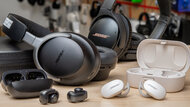
Open-back headphones deliver an immersive listening experience through their unique design. They can produce a wide and spacious soundstage that interacts with your surroundings and makes your listening experience more immersive. Unfortunately, they leak a lot of sound, even if you're listening to music at a reasonable level, and can distract people around you. They also struggle to reduce background noise in your environment because they aren't designed to isolate you. If you're looking for something for mixed-use, check out our recommendations for closed-back headphones. However, this is the place to be if you're seeking a great-sounding experience from your headphones.
We've tested over 835 pairs of headphones, and below are our recommendations for the six best headphones with an open-back design that you can buy. If you're still looking for more headphones, look at our recommendations for the best audiophile headphones and the best headphones for music.
Quick Look





Best Open-Back Headphones
 Audio Reproduction Accuracy8.4Frequency Response Consistency8.4Peaks/Dips7.7See all our test resultsFrequency Response Consistency8.4
Audio Reproduction Accuracy8.4Frequency Response Consistency8.4Peaks/Dips7.7See all our test resultsFrequency Response Consistency8.4The best open-back headphones we've tested are the Sennheiser HD 800 S. These premium dynamic driver headphones are the best for sound but are definitely an investment. Aside from the cost of the headphones, you'll need a powerful amp or audio interface to use them, which is an extra expense if you don't already have one. However, if you want the best, these create an outstanding sense of depth and width to your audio, and really lend your audio some of the qualities of angled reference monitors. They also have an excellent build quality and a very comfortable fit for most people, so you can listen for hours without experiencing much fatigue.
Although they lack a thumpy low bass due to their open-back design, they have a bit of extra high bass to add warmth to the mix. Instruments and vocals sound clear and natural. Their balanced sound profile is suitable for all types of audio content. However, if you want to hear kick drums with a bit more thump, consider the HiFiMan Arya Stealth Magnet Version. The HiFiMan are a little easier to drive than the Sennheiser, so you don't need a dedicated amp or DAC. That said, they're not as comfortable or well-built as our pick, and they can't match the Sennheiser for lending your audio a sense of width and depth.
Best Upper Mid-Range Open-Back Headphones
 Audio Reproduction Accuracy8.3Frequency Response Consistency8.3Peaks/Dips8.2See all our test resultsFrequency Response Consistency8.3
Audio Reproduction Accuracy8.3Frequency Response Consistency8.3Peaks/Dips8.2See all our test resultsFrequency Response Consistency8.3If you want to save some cash, the Sennheiser HD 490 PRO are worth checking out for a dynamic driver design that won't destroy your bank account. They aren't as well-built as our top pick, the Sennheiser HD 800 S, but the HD 490 PRO are still an excellent choice for listeners who enjoy a balanced sound. They put out noticeably more bass than the HD 800 S, but vocals and instruments are still present, detailed, and clear. They're also easier to drive than the HD 800 S, so you likely won't need a headphone amp with most devices.
The HD 490 PRO have consistent audio delivery, so you don't need to worry too much about their sound changing depending on the headphones' fit and positioning on your head. They also have a second set of earpads that change the sound signature a bit, meaning you have access to some extra physical customizability. Plus, if you wear glasses, the earpads have contours meant to fit around them without negatively affecting the bass response.
Best Mid-Range Open-Back Headphones
 Audio Reproduction Accuracy8.0Frequency Response Consistency7.9Peaks/Dips7.9See all our test resultsFrequency Response Consistency7.9
Audio Reproduction Accuracy8.0Frequency Response Consistency7.9Peaks/Dips7.9See all our test resultsFrequency Response Consistency7.9The best mid-range open-back headphones we've tested are the HiFiMan Sundara 2020. These are a pair of planar magnetic headphones with a comfortable, sturdy design. They're quite a bit cheaper than the Sennheiser HD 490 PRO, but the tradeoff is that they underdeliver in low- and mid-bass, so your audio lacks rumble and punch compared to the previous pick. That said, their high-bass response ensures your audio has warmth and fullness, and the rest of the frequency range is very well-balanced, with detailed, bright instruments that don't sound piercing. Their flat sound signature is great for analytical listening, too, making these a good choice for mixing or mastering tasks.
Some listeners may prefer their stretchy headband design, which can make them quite comfortable, but they clamp harder and weigh more than the HD 490 PRO. Their accompanying accessories are also a bit more sparse, which can add up as extra costs, too; unlike the Sennheiser, you only get a single set of earpads, and the Y-cable is less convenient than the locking cable on the HD 490 PRO.
Best Lower Mid-Range Open-Back Headphones
 Audio Reproduction Accuracy8.1Frequency Response Consistency8.3Peaks/Dips7.9See all our test resultsFrequency Response Consistency8.3
Audio Reproduction Accuracy8.1Frequency Response Consistency8.3Peaks/Dips7.9See all our test resultsFrequency Response Consistency8.3Audiophile headphones tend to take a hit in performance once you get into the lower mid-range price point, but the Sennheiser HD 560S avoid that pitfall. These have a decent, albeit more plasticky, build quality and use dynamic drivers, which is typical at this price point and helps keep them fairly lightweight compared to the chunkier HiFiMan Sundara 2020. That said, the Sennheiser are more stable on the head, so if you're an active listener, that's a bonus, and they feel comfortable for long sessions.
Like most open-back headphones, their sound lacks a little low-bass thump, but their balanced sound is great for everything from podcasts to pop music. Instruments sound true-to-life, and vocals have enough clarity to cut through dense mixes. Their treble range closely follows our target curve, but if you want a slightly warmer sound, the HiFiMan might be a better pick.
Best Budget Open-Back Headphones

If you want to dip your toes into the world of open-backs without investing too much, try the Superlux HD 681. These entry-level over-ears are semi-open-back headphones. This design means they leak less audio than their fully open counterparts, like the Sennheiser HD 560S, and block out slightly more ambient sound, although you'll still hear most noise around you. At the same time, they can create a more open, wide, and immersive soundstage than closed-back headphones.
These comfortable headphones reproduce similar amounts of low bass as other picks on this list, though they're certainly considerably brighter overall than the Sennheiser HD 560S. While vocals and instruments are clear and natural, sibilants like hi-hats are relatively piercing. As you'd expect from budget-level cans, their build quality isn't very good, and they feel somewhat flimsy and plasticky. For more durable headphones, it's worth considering the Philips SHP9500, which are better built and fully open-back but cost a bit more.
Best Open-Back Headphones For Gaming
 Audio Reproduction Accuracy7.6Frequency Response Consistency7.6Peaks/Dips8.6See all our test resultsFrequency Response Consistency7.6
Audio Reproduction Accuracy7.6Frequency Response Consistency7.6Peaks/Dips8.6See all our test resultsFrequency Response Consistency7.6While you can use any of the previous picks for gaming, none come with a microphone, so if you don't have a standalone mic and want headphones with one built in, it's worth considering the Drop + Sennheiser/EPOS PC38X instead. Their great boom mic makes your voice clear and natural over team chat. They can also create a greater sense of width and depth than most closed-back gaming headsets, which can be helpful when it comes to locating where enemy footsteps are coming from.
They're very comfortable and come with a choice of microfiber or velour ear cup padding, which is nice if you have a preference. Their flat sound profile suits dialogue and game soundtracks alike, with an accurate mid-range for easily parsing out dialogue. However, they lack low bass like most open-backs, and the treble is a bit dull. Like all the other headphones on this list, they're wired-only and lack companion software with sound customization features like an EQ. If you like to fine-tune your audio using an app and value gamer-centric features like more extensive on-ear controls, consider the Turtle Beach Atlas Air. These open-backs can be used wirelessly as well as wired, which adds to their flexibility. They also have a better mic than the Drop + Sennheiser. On the other hand, the Turtle Beach aren't quite as comfortable as our pick.
Notable Mentions
- Audio-Technica ATH-ADX3000:
If you're looking for premium open-back headphones but can't stretch the budget to the Sennheiser HD 800 S, then the Audio-Technica ATH-ADX3000 are well worth considering. Like the Sennheiser, the Audio-Technica have a flat mid-range that reproduces all kinds of audio content well, but they can't match their more expensive rivals for perceived sense of depth and width.
See our review - Beyerdynamic DT 1990 PRO MKII:
The Beyerdynamic DT 1990 PRO MKII are premium open-backs that are a bit more robustly built than the Sennheiser HD 490 PRO. Both headphones include extra ear pads and cables, but the Beyerdynamic include a case. Still, their frequency response isn't as smooth as the Sennheiser's, with a brighter sound that some might find a touch piercing. But if you like the Beyerdynamic sound, it's a refined take.
See our review - HiFiMan Edition XS:
The HiFiMan Edition XS are a solid contender to the HiFiMan Sundara 2020. While they both use planar magnetic drivers, the Edition XS reproduce audio with a greater sense of space and immersion. However, the Sundara 2020 sport a comfier fit with their flexible headband and offer a bit more stability for listeners who like to move with their music.
See our review - Beyerdynamic DT 990 PRO:
The Beyerdynamic DT 990 PRO are lower mid-range headphones with a better build quality than the Sennheiser HD 560S and a more full-bodied sound thanks to their added high-bass, which some users may prefer for adding a sense of thickness to basslines. However, their audio cable isn't detachable, so if it gets damaged, you'll have to replace the entire unit.
See our review - Philips Fidelio X2HR:
The Philips Fidelio X2HR are wired headphones with a balanced sound similar to the Sennheiser HD 560S. The Philips headphones are built better, but the Sennheiser have fewer peaks and dips across their sound profile, so your audio sounds a bit smoother; you'll have an easier time getting a consistent seal with them, too.
See our review - Corsair VIRTUOSO PRO:
The Corsair VIRTUOSO PRO is a gaming headset with a boom mic that compares favorably to the Drop + Sennheiser/EPOS PC38X. They also have more warmth in the high bass, which can make soundtracks and footsteps in games feel more immersive. But some gamers might find the Corsair a bit too boomy and muddy. The Sennheiser is lighter on the head, so we think it's easier to wear for longer gaming marathons.
See our review
Recent Updates
Jul 22, 2025:
We added the Audio-Technica ATH-ADX3000 to our Notable Mentions as a cheaper alternative to the Sennheiser HD 800 S. We also updated this text throughout to align with Test Bench 2.0. Finally, we added a new summary feature to help our readers more easily identify the right headphones for their needs.
Mar 21, 2025:
We've updated this article to include the HiFiMan Arya Stealth Magnet as an alternative to the Sennheiser HD 800 S and edited the text for clarity. We've added the Beyerdynamic DT 1990 PRO MKII and Corsair VIRTUOSO PRO to the Notable Mentions list.
Dec 18, 2024:
We've made some changes to our picks. The Sennheiser HD 490 PRO replace the HiFiMan Edition XS, as they're more stable and control their sound profile better. The Sennheiser HD 560S replace the Philips Fidelio X2HR for the same reasons. Both previous picks were migrated to the Notable Mentions section.
Sep 18, 2024: The Turtle Beach Atlas Air Wireless are now mentioned in the 'Best Open-Back Headphones For Gaming' category because you can use them wirelessly, and they come with a companion app that lets you tailor the sound to your preferences.
Jun 26, 2024: The Sennheiser HD 490 PRO have been added to this article as a Notable Mention. Otherwise, there are minor text edits.
All Reviews
Our recommendations above are what we think are currently the best headphones with an open-back design for most people to buy. We factor in the price (cheaper headphones win over pricier ones if the difference isn't worth it), feedback from our visitors, and availability (no headphones that are difficult to find or almost out of stock everywhere).
If you would like to choose for yourself, here is the list of all our reviews for open-back headphones. Be careful not to get caught up in the details. There are no perfect headphones. Personal taste and preference will matter more in your selection.
Comments
Best Open-Back Headphones: Main Discussion
What do you think of our picks? Let us know below.
Looking for a personalized buying recommendation from the RTINGS.com experts? Insiders have direct access to buying advice on our insider forum.
Update: We added the Audio-Technica ATH-ADX3000 to our Notable Mentions as a cheaper alternative to the Sennheiser HD 800 S. We also updated this text throughout to align with Test Bench 2.0. Finally, we added a new summary feature to help our readers more easily identify the right headphones for their needs.
What do you think of these changes? Let us know
- 21010
Can you give an additional recommendation between the $40 budget pick and the ~$190 Lower Mid-Range pick? It is quite a big price gap between them. I don’t really know about the category of open-back headphones. But I am looking to buy my first set and would like something in $100 range. I know this is a more niche category and there is a possibility there might not be anything suitable in that price range.
We’ve just released a new video that mentions the Beyerdynamic DT 990 PRO and Sennheiser HD 490 PRO here.




































































































